Now that you’re in college, you may have realized that you’ll need to figure out how to do your laundry. This is an issue that every student faces. Luckily, doing laundry in college is easy if you know how to do it right.
To do your laundry in college, pick a suitable time. Sort your items and pre-treat stains. Prepare the necessary laundry supplies. Once in the laundry room, load your clothes, choose the correct washing and drying cycle or settings, and fold your laundry.
In this article, I’ll share how you can do laundry in college the easy way. Let’s get started!
1. Pick the Right Time To Do Laundry
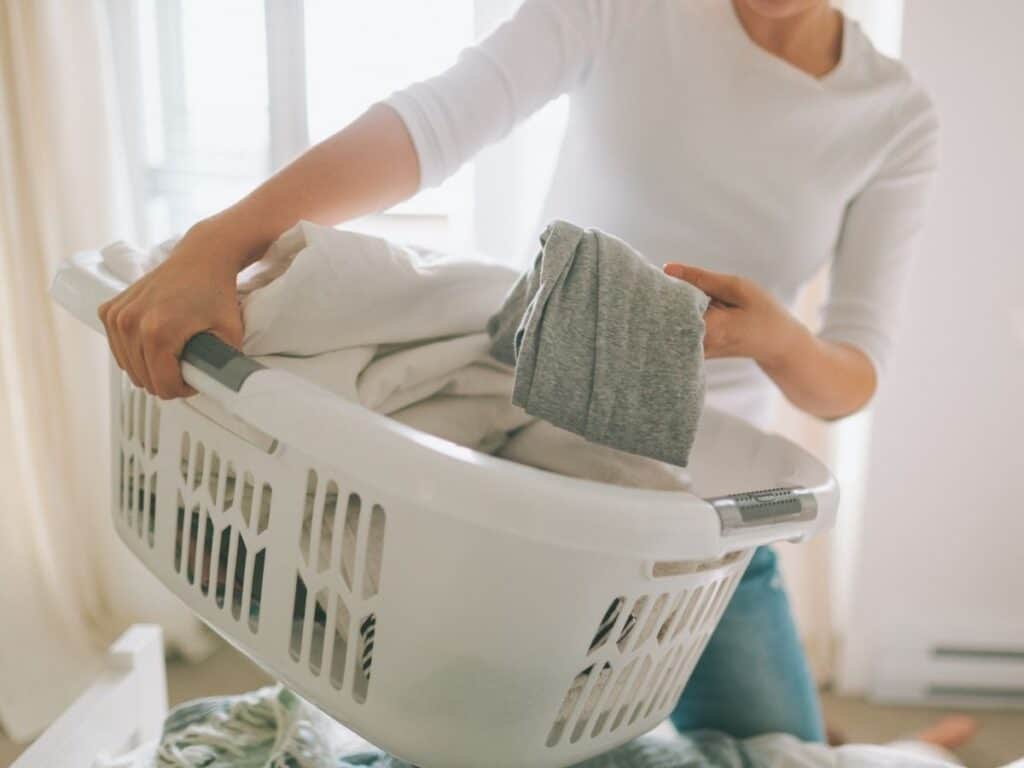
The right timing is essential when you’re doing laundry in a dorm. Certain days and times of the day can get very busy, placing a high demand on the washers and dryers in the laundry room.
If your schedule permits, choose a day or time slot that is typically quiet so that you don’t have to wait in line to use the machines.
The best day to do your laundry is typically a weekday afternoon. You can also do it when there are big events on campus, such as a football or basketball game. Of course, this may not work for everyone, especially if you want to be part of these events.
Most college students will do their laundry on the most convenient day, which can vary from week to week. However, it’s best to set a schedule and make it a part of your routine.
If you’re lucky and your college dorm has an app alerting students when washers and dryers are free, use it. In this case, you’ll need to gather your laundry quickly and be ready to go so you don’t miss out on the opportunity.
2. Sort Before You Wash
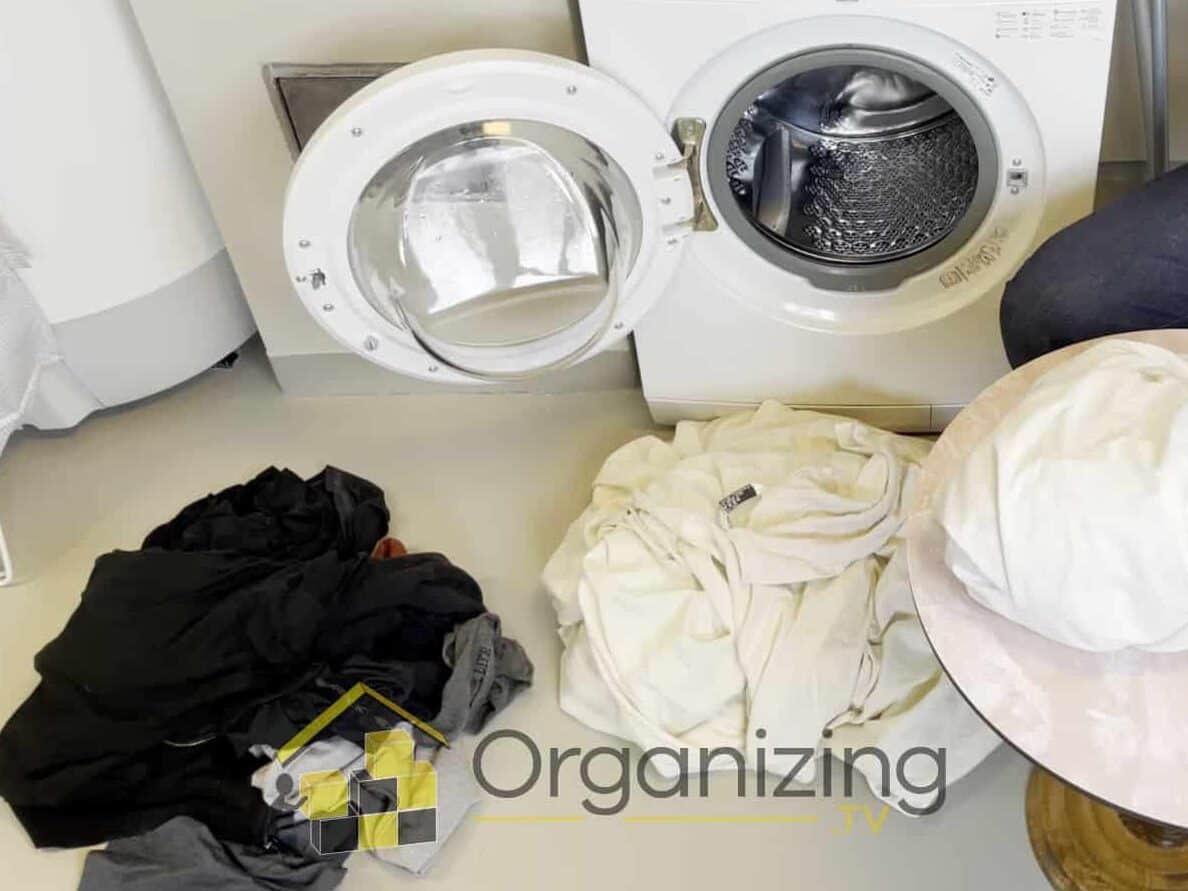
It’s not a good idea to rush to the laundry room or load your clothes in the washer immediately. Before anything else, sort your laundry.
Invest in a suitable laundry hamper that will allow you to sort your clothes. This way, you won’t need to separate them during laundry day.
Sort your clothes depending on their colors, and divide them into three groups:
- White
- Light
- Dark
Wash each clothing group separately to avoid the darker colors bleeding into the light-colored clothes. For example, if you wash a bright red item with a white t-shirt, your t-shirt may become pink after the laundry cycle.
When separating your clothes, you must also read the label. For instance, some might say “hand wash only.” If that’s the case, then you shouldn’t mix it with those you can machine-wash. It may also state whether it’s safe to put it in the dryer.
3. Prepare Your Laundry Supplies
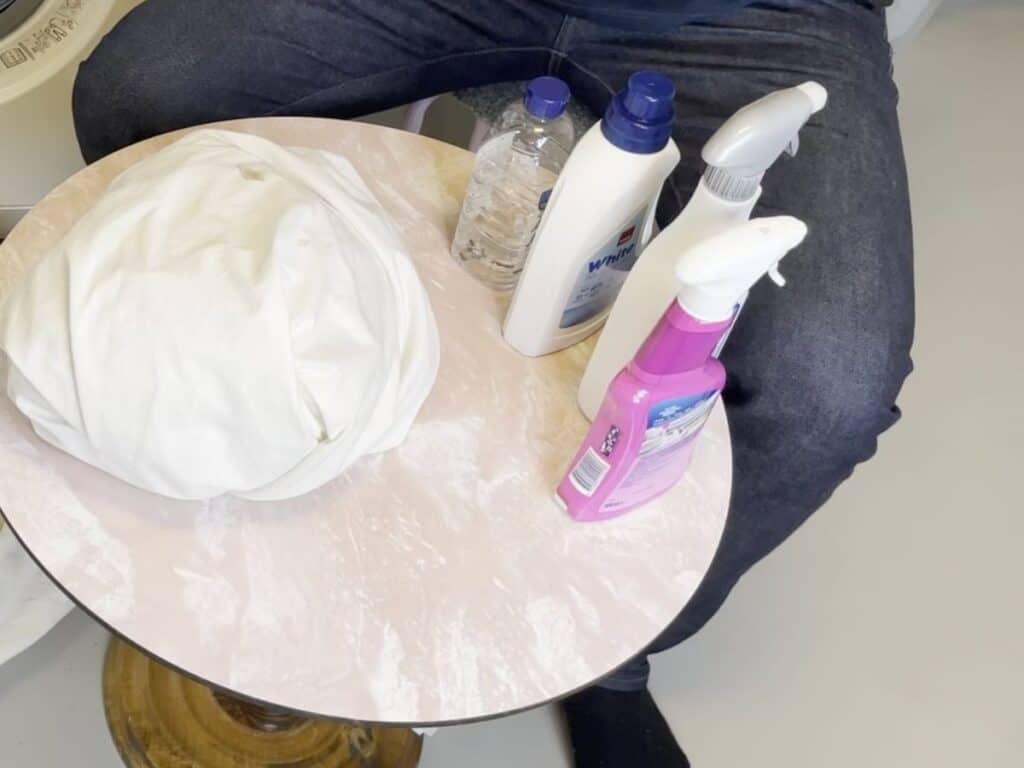
Before you head to the laundry area, make sure you have the correct supplies. This will spare you the hassle of going back and forth and can save time. Below is a list of the essential laundry supplies you’ll need:
- Laundry detergent: This is the most important item. If you want to remove stains and brighten whites, laundry detergents with bleach are great, but you should avoid using them on colored fabrics. For eco-conscious students, consider a green detergent. If you have sensitive skin, use a gentle detergent.
- Stain remover: Chlorine bleach is one of the most common stain removers but can only be used on white fabrics. Stain remover pens can be handy alternatives.
- Mesh bag: A mesh bag can be handy when washing small items, such as socks and underwear. You can keep them in a mesh bag and throw the bag in the washer.
- Dryer sheets: Besides cutting down on static, dryer sheets are great for incorporating a fresh smell to your clothes. They will also soften them for easier wrinkle removal.
- Fabric softener. Fabric softener is not essential, but, like dryer sheets, it can help prevent wrinkles from forming in your laundry, cutting down on ironing time. It also makes clothing feel softer and more comfortable against your skin.
- Payment. Before heading to the laundry, you should know how you’ll pay for your laundry. Many washers take quarters, but modern dorm laundries allow you to use a card or even an app.
4. Follow College Dorm Laundry Etiquette
Many people likely use your dorm laundry, and it pays to be kind and mindful of them.
Below are some things to remember:
- Ask when you’re using other people’s laundry items. For instance, if you run out of detergent and need to use your roommate’s, ask for permission. Also, don’t assume anything you find in the laundry room is for anyone to use.
- Come prepared. Before leaving your room, make sure that your clothes are sorted and your supplies are ready. This way, you won’t disturb others in the laundry room, especially when it’s cramped.
- Avoid using too many washers and dryers. Stick to one or two machines, one for light-colored and another for dark-colored clothing. Give others a chance to use the other machines.
- Refrain from removing other people’s clothes from washers or dryers. If it has been there for a long time, inform the laundry room attendant if there is one.
- Clean the lint trap after using dryers. Excess lint in the drum can be a fire hazard and make it harder to dry clothes.
5. Pre-Treat Stains
Before putting clothes, towels, sheets, or anything else in the dryer, look for stains or tough dirt. It’s best to pre-treat them before starting a normal wash cycle. Otherwise, they might remain even after washing.
Timing is crucial in stain removal, and it’s best to pre-treat stains when they’re fresh. You can use a stain remover and soak the fabric in cold water. Once you’re done, put them in the washer.
If you’re clueless about removing stains on your clothes, watch the short video below because it provides useful hacks that can save your clothes:
6. Load Your Laundry in the Washer
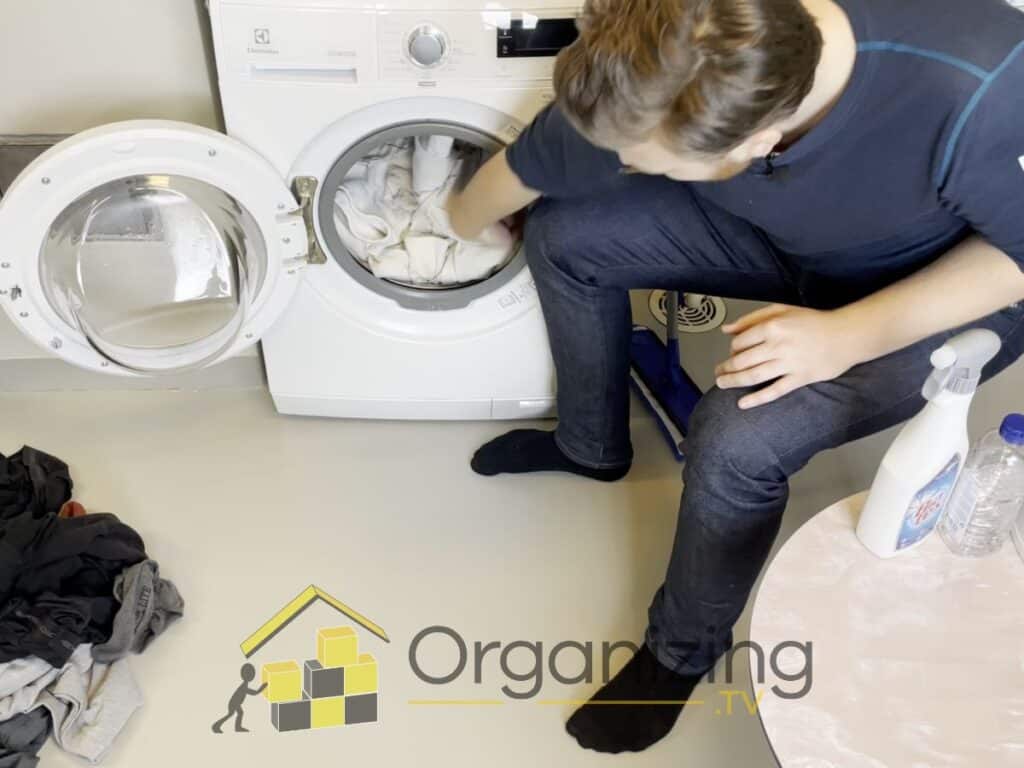
When you’re ready to wash, put your laundry in the washer, and work in batches. Use a separate wash cycle for light and dark colors, and consider turning the laundry inside out to prevent graphics or logos from fading or being ruined.
It’s also advisable to check the washer’s maximum capacity, so you don’t overload it. Filling a washer to the brim can feel tempting, especially if you have a lot of laundry to do. However, it may result in your clothing not being washed properly.
As a general rule of thumb, you should only fill the washer’s drum two-thirds of its capacity.
Here is a guide I made for you on how many clothes you can load in the washer depending on its weight capacity.
7. Start Washing
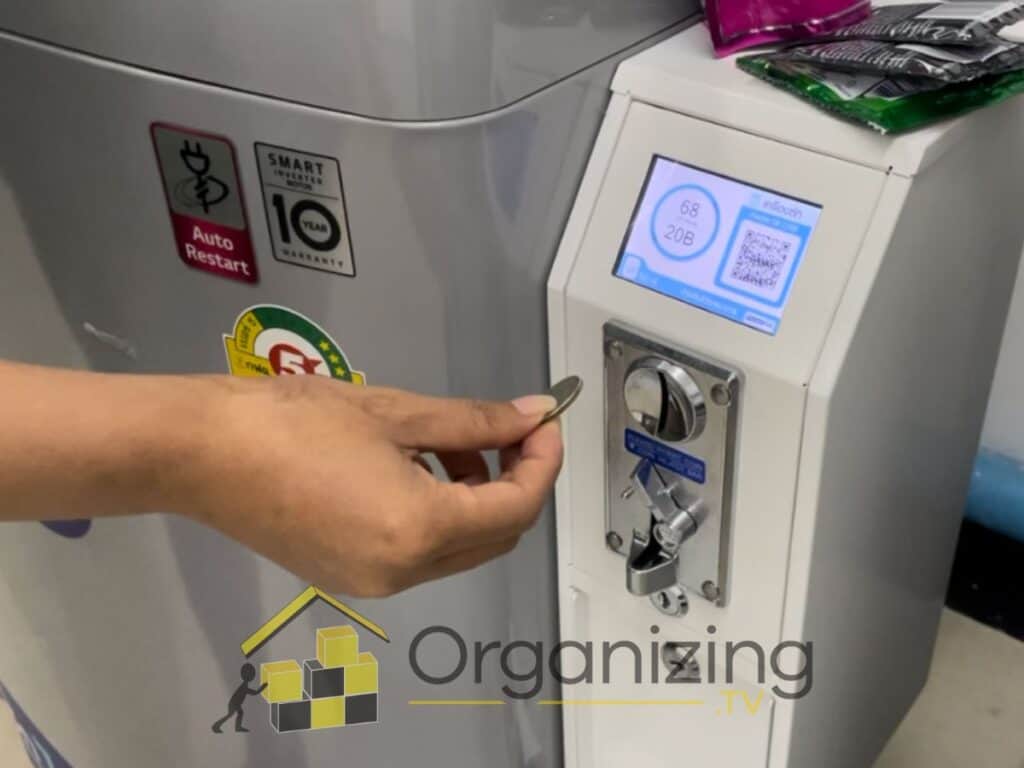
Washing your laundry is the most important part, and here are some things you need to do before selecting the correct washing cycle:
- Pour laundry detergent in the washer. Most washers require you to place the detergent in a drawer, and in a laundry room, there is usually a poster above the washer explaining which drawer section is for the detergent. If you’re using laundry pods, you can place them in the drum with your laundry. Always use the correct amount of detergent, according to the label.
- Add fabric conditioner. Fabric conditioner is optional. Like laundry detergent, there is typically a dedicated slot with a maximum fill line for it.
- Choose the washer cycle or temperature. Cold is best for dark colors and delicate fabrics. On the other hand, hot is ideal for towels and sheets. For most of your clothes, however, warm water will work.
- Close the lid or door. The machine will usually only start if you close the lid or door properly.
- Pay for the load. Doing so will depend on the machine. Most washers have a slot where you can put your coins. Others will have a terminal for a credit card or student ID, while some will have an app. After paying, hit Start.
- Take note of the cycle time. Most dorm washers have a digital or analog display showing you how much long the washing cycle still has before it’s finished. This will help you to plan your time effectively.
Here’s an article on how long it will take you to do laundry in general.
8. Place Your Laundry in the Dryer

When the washing cycle is complete, you can open the washer’s lid or door, and transfer your wet laundry to the dryer. Try and do this promptly to give other students a chance to use the washer.
Before putting your clothes in the dryer, check the lint trap, and remove any lint or dust. This will ensure that the dryer can work more efficiently.
Choose the appropriate setting for the dryer. Medium temperature is a safe choice for most items. Avoid choosing high temperatures, as they can be damaging. If you’re drying delicate fabrics, low temperature is the best setting.
Before starting the dryer cycle, below are some items you should never put in the dryer:
- Swimsuits
- Bras
- Tights
- Leather, suede, or velvet items
- Rubber-backed bath mats
- Garments with embellishments
Also, don’t put anything in the dryer that you don’t want to shrink.
Drying usually takes 45 minutes to an hour. However, it can be longer if you’re drying thick items, such as comforters or towels.
9. Fold or Hang Your Laundry
When the dryer cycle is complete, you can unload the clothes and place them in your laundry hamper. Don’t fold them in the laundry room if it’s busy because this will contribute to the laundry room being too cramped.
Fold or hang your clothing as soon as possible to avoid wrinkles.
More on folding your clothes here.
Doing Laundry in College – Questions and Concerns
Below are some commonly-asked questions about doing laundry in a college dorm:
Can You Do Laundry in a College Dorm?
You can do laundry in a college dorm. Most college dorms have laundry facilities, which you can usually find on the ground floor or basement. If you’re unsure, ask the administrative staff, and they’ll point you in the right direction.
The best option for those without laundry facilities is to find a laundromat nearby. You can do your laundry in the bathroom or kitchen, although this is time-consuming and labor-intensive. This is especially true if you have a small space. Air drying your clothes can also be challenging but not impossible.
Investing in a washer and dryer can also be a good idea. However, it works only if you have the space to spare in your dorm, which is not usually the case with dorms.
How Often Should You Do Laundry in College?
College life is busy and full, and it can be difficult to find time to do laundry. You should do laundry once you have a full load to wash. For one student, this is usually every one to two weeks.
Here’s a quick guide on how often to wash common items:
- Shirts, swimsuits, tights, leggings, socks, and underwear: After every use
- Jeans, dresses, sweaters, and pajamas: After three to four wears
- Bed sheets: Every one to two weeks
- Mattress pads, pillow liners, and bathrobes: Monthly
- Blankets, comforters, and heavy coats: Every quarter
I made a more detailed guide here if you have any more questions.
How Do You Dry Clothes in a Dorm Room?
We’ve noted earlier that not everything should go in the dryer, especially delicate clothes. Line-drying isn’t always an option because you might not have the luxury of space in your campus living facility.
You can buy a small clothes drying rack that can fit in your room. Be strategic in its placement, picking a place that the sun directly hits. Alternatively, place your wet laundry next to heaters, fans, or boilers. If the weather is warm and dry, open the windows to speed up drying.
Ironing your garments can also be a viable solution. However, you do not iron the fabric directly. Instead, you should put a towel in between.
Conclusion
There’s no shame in admitting that you don’t know how to do laundry. Lucky for you, it’s easy! Most campus living facilities will include a laundry room with washers and dryers. Nonetheless, you must know how to use them correctly, such as choosing the proper wash and dry settings.
Alternatively, you could also look into having a laundry service provider do the laundry for you, but that is often more costly.


I’m an expert wardrobe organizer and a bit of a clean freak. I created this website and its YouTube channel to share practical guides about laundry and organizing. My teachings have been featured in multiple large news publications, and I’ve self-published two wardrobe organizing books and an entire course on the subject.
